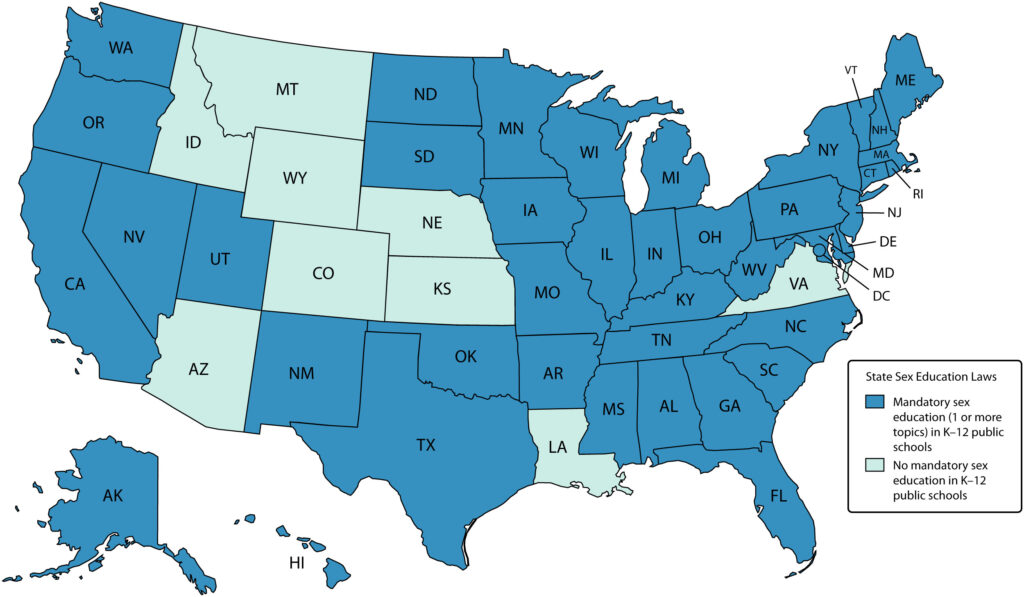Sex Ed by State Lines
With no national standard for sex education, the U.S. has a patchwork of policies that reflect local politics more than public health.

Read Time: 5 minutes
Published:
Teens and adolescents face high rates of sexually transmitted infections and unplanned pregnancy. However, these trends can be reversed with comprehensive sex education. Research shows that sex education delays the start of sexual activity, lowers rates of unintended pregnancy, and increases contraception use. Parents and teens routinely express a desire for medically accurate sex education to be taught in schools, but in practice, what students learn depends on where they live.
The United States hasn’t set a national standard for sex education, unlike other countries, including Sweden, the United Kingdom, and the Netherlands. Instead, state legislatures pass laws and district school boards decide the curriculum, producing a patchwork of policies that reflects local political leanings more than public health best practices. Additionally, a vocal minority of parents is calling for more restrictions on what can be taught in classrooms, framing their demands as a matter of family autonomy. These parents’ rights groups and public health advocates are increasingly at odds over what young people should learn about sex, gender, and relationships in school.
“The parental rights movement is louder than it used to be, but it’s not new,” said Dr. Kimberly Nelson, an associate professor of community health sciences at Boston University School of Public Health, whose work focuses on sexual health inequities. “We are a country founded on puritanical beliefs, and that’s carried through into our educational system, including our sex ed laws.”
Amid the shifting political climate, many states have revisited their sex education laws in recent years. To see how this political momentum is playing out in policy, Nelson and colleagues reviewed state laws, regulations, and court decisions on sex education across all 50 states and Washington, D.C. Her team documented the topics states require, whether instruction must be medically accurate, and how parental consent rules the curriculum.

Of the 3.5 million students who graduated from U.S. public high schools in 2025, 89% had taken a sex education class. As shown in the map, most states have laws that require public school students to take a course that covers at least one sexual education topic, such as HIV/AIDS, healthy relationships, or prevention of child sexual abuse. However, fewer than half of these states mandate that classes cover contraception or consent to sex. Just 14 states specifically require that the entire curriculum be medically accurate. An additional 5 states only specify that certain topics, such as abstinence and contraception failure rates, be medically accurate.
“As with many things in life, policy often follows the money, and in this case, federal dollars for sexual education are still tied to abstinence,” Nelson said. “Federal funding often requires abstinence-based education, despite decades of research showing it’s not effective.”
The study also highlights gaps in equality and access. Only 12 states require that schools teach about sexual orientation, and two specifically mandate that the content be negative. For example, Texas’s law specifies that course materials emphasize that “homosexuality is not a lifestyle acceptable to the general public.” In 34 states, parents can opt their children out of sex education, and in 5 states, students can only participate if parents opt them in.
When sex education skips topics like contraception or consent, and when parents can easily pull students out of class, young people miss a critical chance to learn skills that will protect their health. And if lessons aren’t required to be accurate, students may come away with the mistaken idea that sexually transmitted infections always cause obvious symptoms or that contraception is ineffective
‘Parents and teens want sex ed, they want the best sex ed possible, and they want it to happen at school,’ Nelson said.
On the other hand, sex education laws set the minimum standard that needs to be met. Then it’s up to school boards and teachers to decide if they want to cover additional topics beyond what is mandated by the law.
“We’re asking local districts to figure out what good sex ed looks like and putting a lot of pressure on teachers who are already stretched thin,” said Nelson. “If the laws mandated more comprehensive sex education, which is what is supported by the research, administrators and educators would then be required to provide it and would have the ability to point to those requirements when parents or community members push back.”
Some schools may exceed the minimum standards defined by the law, but not all will. This variation creates inequity in sexual health literacy between students who receive comprehensive sex education and those who do not. Updating state policies to require medically accurate and inclusive instruction would raise the minimum standard, bringing classrooms in line with decades of research and giving all adolescents the tools they need to make safer choices.
Still, there is reason to be hopeful. “Parents and teens want sex ed, they want the best sex ed possible, and they want it to happen at school,” Nelson said. “We also have many states that set a good example of what comprehensive sex education, as mandated by a state, can look like, which gives other states examples that they can adopt.”



